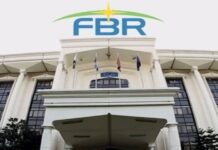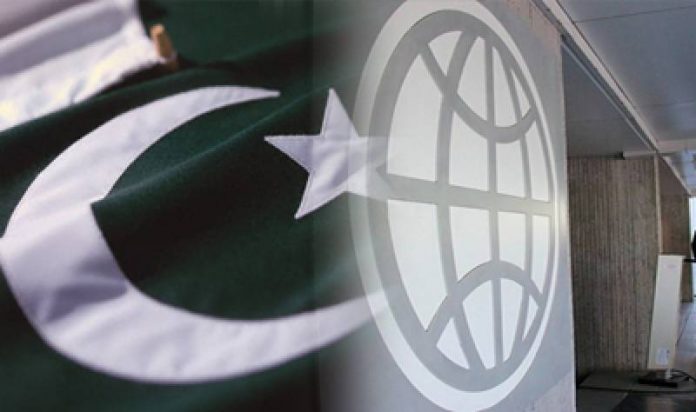by AMER SIAL
Pakistan’s economy continues to grow, but beneath the surface, a number of warning signs are emerging, says the World Bank’s Pakistan Development Update report, which notes with concern that revenue growth is slowing, the fiscal deficit is growing, exports continue to fall and energy sector circular debt has resurfaced.
These emerging concerns suggest that renewed policy emphasis is required on macroeconomic stability to prevent the country from losing the impressive gains achieved and other structural reforms, such as those required in the energy sector, it notes.
While the federal government necessarily carries the majority of this burden, provincial governments also have a part to play. It especially calls for Pakistan’s most populous province, Punjab, to take measures to increase its own source revenue, equipping youth with employable skills and ensuring the proper share in the benefits of growth. This could be achieved by improving agricultural productivity and addressing distortive subsidies, which are impeding growth.
The report says the structural bottlenecks within Pakistan combined with low growth in destination markets resulted in weakened textile exports at both the high and low ends of the value chain. The significant trade deficit was partially offset by remittances, which are historically a major source of import financing, are also starting to taper off, declining for the first time in over a decade. This was largely driven by deteriorating economic conditions in GCC countries, which account for almost two-thirds of Pakistan’s remittances.
Despite declining remittances, Pakistan is, on balance, benefitting from low oil prices, thus a sharp increase in international prices would worsen the trade deficit and present fiscal risks in the form of an increase in energy subsidies.
The first half of FY17 suggests deteriorating internal and external balances. Privatisation efforts have stalled, which has also affected the broader reform efforts in the electricity sector, with the resurgence of circular debt.
FBR performance in tax collection is below target after several years of very strong performance. Reforms in areas that require collaboration between federal and provincial governments remain challenging.
The provinces also have a role to play in promoting ongoing economic growth. Punjab’s own-source tax revenues have grown significantly over the recent years, but they remain only 25 per cent of their estimated potential.
The World Bank estimates Punjab’s revenue potential at Rs 432 billion, compared with an actual collection in FY16 of Rs 108 billion. This tax gap is driven by a mixture of tax policy and administration shortcomings.
Particular challenges include jurisdictional overlaps between different levels of government; large tax exemptions; low compliance; weaknesses in tax administration; and weak coordination among provincial administration bodies. The most significant tax gaps are associated with the General Sales Tax on Services and the Urban Immoveable Property Tax, which could vastly increase their collections by eliminating exemptions, increasing the range of services or properties subject to the taxes, and through more accurate data on the services sector and property valuations.
The agriculture sector has underperformed, growing at less than 3 per cent in each of the past five years. Limited water availability combined with low user charges and limited water storage creates significant water stress. Agricultural productivity is considerably low, as crop yields per hectare and per cubic meter of water are far lower than international benchmarks.
These problems are not always eased by existing agricultural subsidies. Punjab’s vast wheat procurement system generates significant distortions, stimulating the extra production of a crop that is already overstocked and discouraging diversification. The cost of the programme is significant, with direct costs estimated at Rs 35 billion a year.
A news release of the World Bank said Pakistan’s Gross Domestic Product growth in Fiscal Year 2017 is expected to climb to 5.2 percent — the highest in nine years — and the growth rate will continue to accelerate, reaching 5.5 percent in FY18 and 5.8 percent in FY19.
Released twice a year, the Pakistan Development Update sets out recent developments across the economy and identifies risks and opportunities in the near-term future before focusing on a handful of key development challenges.
Pakistan’s growth will continue to benefit from growing consumer and investor confidence in the first half of FY17, following the successful efforts to restore macroeconomic stability during the last 4 years. The report highlights that more recently, weakening trade and fiscal balances point toward the need to continue with the reform efforts to consolidate the hard-won stability.
“Pakistan’s accelerating growth is good news and reflects the country’s success in building confidence, but the pace of reforms has slowed and it is important for the structural reforms to accelerate,” said WB Country Director Illango Patchamuthu.
A moderate increase in investment is expected to supplement growth, driven primarily by public and private consumption. But the country’s current account deficit and fiscal balances deteriorated in the first half of the financial year, which could affect the reform momentum.
“Since the 18th Constitutional Amendment, many important reform areas are now shared responsibility. Provinces have a significant role to play in fiscal consolidation, energy sector reforms and business environment, not to mention their role in delivering high-quality health and education services,” said Muhammad Waheed, World Bank senior economist for Pakistan.
“Effective collaboration between federal and provincial governments will be crucial if Pakistan has to deliver on its growth potential.”
The report discussed a number of challenges that the provincial governments were facing. Using Punjab as an example, it is highlighted that while provincial own-source revenues have significantly increased in recent years, there could have been further significant gains, if tax policy and administration reforms were implemented.
The Punjab government is putting in efforts to significantly increase the scale of technical and vocational training programmes in an attempt to boost job prospects for the province’s ‘youth bulge’. Several next steps in this area are identified in the report including the application of quality standards and the introduction of initiatives to improve matching between job seekers and prospective employers.
























